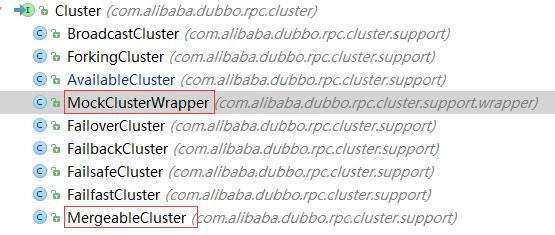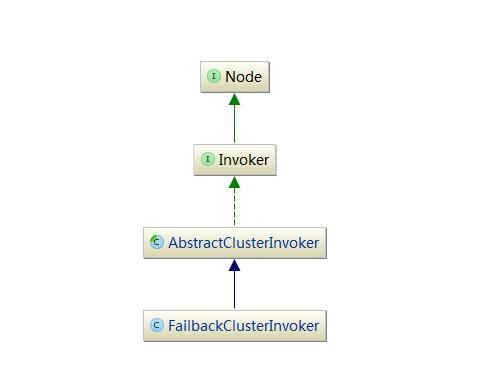接上篇https://my.oschina.net/u/146130/blog/1554766
dubbo版本2.5.3
dubbo本身集群容错策略有7种。都实现了Cluster接口(spi扩展点)
从类结构上看,Cluster接口有9个实现类(其中MockClusterWrapper是服务降级处理用的,MergeableCluster是分组合并结果用的)

Cluster接口只有一个方法
/**
* Merge the directory invokers to a virtual invoker.
*
* @param <T>
* @param directory
* @return cluster invoker
* @throws RpcException
*/
@Adaptive
<T> Invoker<T> join(Directory<T> directory) throws RpcException;方法实现逻辑是,把directory目录服务中多个提供者,经过容错和负载均衡机制包装,以一个虚拟的Invoker返给上层传调用。
每个虚拟的Invoker类型,就是一种集群策略。
比如dubbo默认的集群策略failover类的实现
public class FailoverCluster implements Cluster {
public final static String NAME = "failover";
public <T> Invoker<T> join(Directory<T> directory) throws RpcException {
return new FailoverClusterInvoker<T>(directory);//包装成的虚拟Invoker类型是FailoverClusterInvoker,就是个集群容错策略
}
}FailoverClusterInvoker 类扩展了抽象类AbstractClusterInvoker,实现了AbstractClusterInvoker的
抽象方法doInvoke()用于实现具体集群策略,如下图

AbstractClusterInvoker实现了Invoker接口唯一方法invoke,对外层调用,如下
public Result invoke(final Invocation invocation) throws RpcException {
checkWhetherDestroyed();
LoadBalance loadbalance;
//从目录中获取所有的服务提供者
List<Invoker<T>> invokers = list(invocation);
//获取负载均衡策略
if (invokers != null && invokers.size() > 0) {
loadbalance = ExtensionLoader.getExtensionLoader(LoadBalance.class).getExtension(invokers.get(0).getUrl()
.getMethodParameter(invocation.getMethodName(), Constants.LOADBALANCE_KEY, Constants.DEFAULT_LOADBALANCE));
} else {
loadbalance = ExtensionLoader.getExtensionLoader(LoadBalance.class).getExtension(Constants.DEFAULT_LOADBALANCE);
}
RpcUtils.attachInvocationIdIfAsync(getUrl(), invocation);
return doInvoke(invocation, invokers, loadbalance);//调用子类实现具体的容错策略。
}可以看到其他几种集群策略都是这种方式。其实就是模板方法模式。
所以,通过看每种集群容错类的doInvoke方法的具体实现,就可以理解每种的容错策略。
前一篇,看了failover和available集群策略,下面再看看其他五种集群策略。
broadcast策略:
public Result doInvoke(final Invocation invocation, List<Invoker<T>> invokers, LoadBalance loadbalance) throws RpcException {
checkInvokers(invokers, invocation);
RpcContext.getContext().setInvokers((List) invokers);
RpcException exception = null;
Result result = null;
//遍历调用所有的服务列表,并把结果覆盖以前的。
for (Invoker<T> invoker : invokers) {
try {
result = invoker.invoke(invocation);
} catch (RpcException e) {
exception = e;
logger.warn(e.getMessage(), e);
} catch (Throwable e) {
exception = new RpcException(e.getMessage(), e);
logger.warn(e.getMessage(), e);
}
}
//其中有一个失败,直接抛异常
if (exception != null) {
throw exception;
}
return result;
}这个策略通常用于通知所有提供者更新缓存或日志等本地资源信息
forking 策略:
public Result doInvoke(final Invocation invocation, List<Invoker<T>> invokers, LoadBalance loadbalance) throws RpcException {
checkInvokers(invokers, invocation);
final List<Invoker<T>> selected;
//获取并行调用个数
final int forks = getUrl().getParameter(Constants.FORKS_KEY, Constants.DEFAULT_FORKS);
//超时时间
final int timeout = getUrl().getParameter(Constants.TIMEOUT_KEY, Constants.DEFAULT_TIMEOUT);
if (forks <= 0 || forks >= invokers.size()) {
selected = invokers;
} else {
selected = new ArrayList<Invoker<T>>();
//通过负载均衡策略,选出要并行调用的invokers,放入selected列表
for (int i = 0; i < forks; i++) {
//在invoker列表(排除selected)后,如果没有选够,则存在重复循环问题.见select实现.
Invoker<T> invoker = select(loadbalance, invocation, invokers, selected);
if (!selected.contains(invoker)) {//防止重复添加invoker
selected.add(invoker);
}
}
}
RpcContext.getContext().setInvokers((List) selected);
final AtomicInteger count = new AtomicInteger();
final BlockingQueue<Object> ref = new LinkedBlockingQueue<Object>();
//遍历selected列表,通过线程池并发调用
for (final Invoker<T> invoker : selected) {
executor.execute(new Runnable() {
public void run() {
try {
Result result = invoker.invoke(invocation);
//把结果放入队列
ref.offer(result);
} catch (Throwable e) {
int value = count.incrementAndGet();
//所有的都异常了,才把异常加入到对了尾部
//这就保证了,只要有一个成功,ref.poll()方法从队列头部就能取得到结果返回。
if (value >= selected.size()) {
ref.offer(e);
}
}
}
});
}
try {
//从队列头部就能取得到结果,返回,如果是异常,就抛出。
Object ret = ref.poll(timeout, TimeUnit.MILLISECONDS);
if (ret instanceof Throwable) {
Throwable e = (Throwable) ret;
throw new RpcException(e instanceof RpcException ? ((RpcException) e).getCode() : 0, "Failed to forking invoke provider " + selected + ", but no luck to perform the invocation. Last error is: " + e.getMessage(), e.getCause() != null ? e.getCause() : e);
}
return (Result) ret;
} catch (InterruptedException e) {
throw new RpcException("Failed to forking invoke provider " + selected + ", but no luck to perform the invocation. Last error is: " + e.getMessage(), e);
}
}并行调用多个服务器,只要一个成功即返回。通常用于实时性要求较高的读操作,但需要浪
费更多服务资源。可通过 forks="2" 来设置最大并行数。
failback策略:
protected Result doInvoke(Invocation invocation, List<Invoker<T>> invokers, LoadBalance loadbalance) throws RpcException {
try {
checkInvokers(invokers, invocation);
//通过负载均衡策略选择一个invoker
Invoker<T> invoker = select(loadbalance, invocation, invokers, null);
return invoker.invoke(invocation);
} catch (Throwable e) {
//失败后,记录异常日志,不抛出异常,
logger.error("Failback to invoke method " + invocation.getMethodName() + ", wait for retry in background. Ignored exception: "
+ e.getMessage() + ", ", e);
//把异常调用记录入异常hashmap,key是调用的方法信息,value是invoker本身
addFailed(invocation, this);
return new RpcResult(); // ignore
}
}
/***
* 创建调度器,放入重试对象
*/
private void addFailed(Invocation invocation, AbstractClusterInvoker<?> router) {
if (retryFuture == null) {
synchronized (this) {
if (retryFuture == null) {
//调度线程池,周期性(5秒一次)的调用retryFailed方法
retryFuture = scheduledExecutorService.scheduleWithFixedDelay(new Runnable() {
public void run() {
// 收集统计信息
try {
//执行之前异常方法的调用
retryFailed();
} catch (Throwable t) { // 防御性容错
logger.error("Unexpected error occur at collect statistic", t);
}
}
}, RETRY_FAILED_PERIOD, RETRY_FAILED_PERIOD, TimeUnit.MILLISECONDS);
}
}
}
//放入map
failed.put(invocation, router);
}
/***
* 遍历失败hashmap failed 取出调用环境栈,执行调用
*/
void retryFailed() {
if (failed.size() == 0) {
return;
}
for (Map.Entry<Invocation, AbstractClusterInvoker<?>> entry : new HashMap<Invocation, AbstractClusterInvoker<?>>(
failed).entrySet()) {
Invocation invocation = entry.getKey();
Invoker<?> invoker = entry.getValue();
try {
//执行调用
invoker.invoke(invocation);
failed.remove(invocation);
} catch (Throwable e) {
logger.error("Failed retry to invoke method " + invocation.getMethodName() + ", waiting again.", e);
}
}
}此策略失败自动恢复,后台记录失败请求,定时重发。通常用于消息通知操作。
failsafe策略:
public Result doInvoke(Invocation invocation, List<Invoker<T>> invokers, LoadBalance loadbalance) throws RpcException {
try {
checkInvokers(invokers, invocation);
//利用负载均衡选择一个调用者
Invoker<T> invoker = select(loadbalance, invocation, invokers, null);
return invoker.invoke(invocation);
} catch (Throwable e) {
//如果有异常,记录异常信息,返回空值,不抛出异常
logger.error("Failsafe ignore exception: " + e.getMessage(), e);
return new RpcResult(); // ignore
}
}失败安全,出现异常时,直接忽略。通常用于写入审计日志等操作。
failfast策略
public Result doInvoke(Invocation invocation, List<Invoker<T>> invokers, LoadBalance loadbalance) throws RpcException {
checkInvokers(invokers, invocation);
Invoker<T> invoker = select(loadbalance, invocation, invokers, null);
try {
return invoker.invoke(invocation);
} catch (Throwable e) {
//如果有一次异常,立即抛出异常
if (e instanceof RpcException && ((RpcException) e).isBiz()) { // biz exception.
throw (RpcException) e;
}
throw new RpcException(e instanceof RpcException ? ((RpcException) e).getCode() : 0, "Failfast invoke providers " + invoker.getUrl() + " " + loadbalance.getClass().getSimpleName() + " select from all providers " + invokers + " for service " + getInterface().getName() + " method " + invocation.getMethodName() + " on consumer " + NetUtils.getLocalHost() + " use dubbo version " + Version.getVersion() + ", but no luck to perform the invocation. Last error is: " + e.getMessage(), e.getCause() != null ? e.getCause() : e);
}
}快速失败,只发起一次调用,失败立即报错。通常用于非幂等性的写操作,比如新增记录。最后有个终结篇https://my.oschina.net/u/146130/blog/1569554






















 513
513

 被折叠的 条评论
为什么被折叠?
被折叠的 条评论
为什么被折叠?








